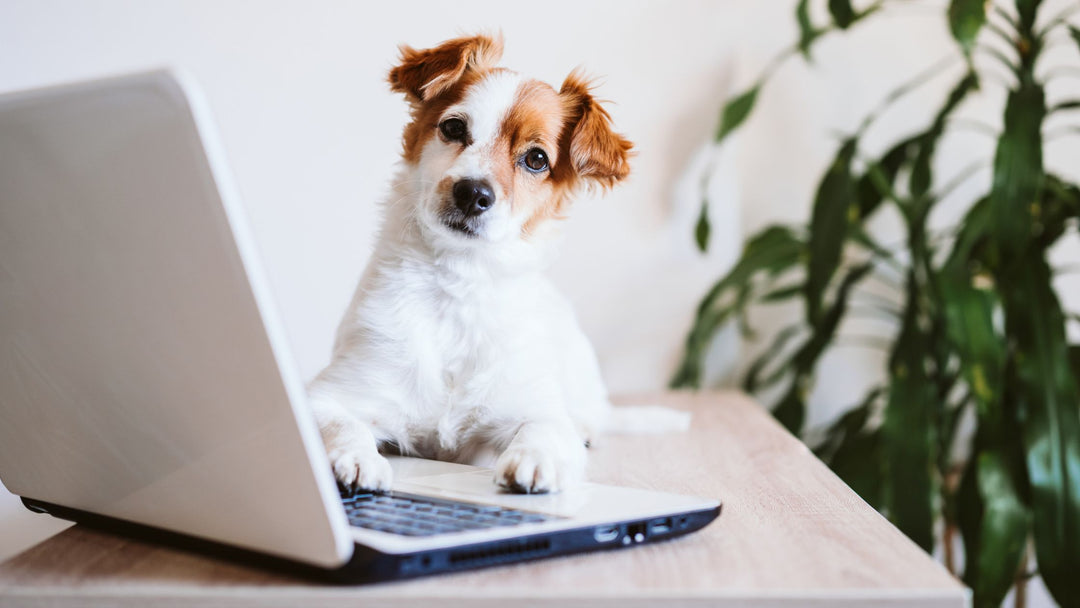The Art of Petting

You see a puppy or a dog. The very first thing you want to do is reach out and pet said puppy or dog. They are fluffy, they are cute, they are adorable, they are squishable...YOU MUST PET THEM! Before you lunge in to get your pet on, here's a question for you: do you have any idea how to properly pet a dog?
Petting and dogs go together in our common nomenclature like peanut butter and jelly, butter and toast, sauce and spaghetti...I've run out of food analogies, but you get the point. Everyone thinks: see puppy or dog, must pet.
Here's the thing: petting is an art and a dance.
Physical interaction between two individuals of any species is a delicate balance. Have you ever been involved in a hand shake or a hug that went on for too long? If so, it was likely uncomfortable, maybe unsettling, perhaps even unnerving or panic-inducing...if you are as adverse to hugs as I am.
The point being, two individuals making physical contact must be done in a way that is appropriate for both of them. Yet, when we are talking about our dogs, we're talking about figuring out what another species would enjoy within a given context.
Translation: petting appropriately can be a hard thing to master! No worries, I've got some tips for you.
Petting: On and Off Buttons
That's right, you can use petting as an "On" and "Off" button for you dog! Of sorts, obviously, not an actual on-off switch, but the ability to affect your dog's overall excitement and arousal level simply by effectively using your touch is a very real thing.
Most people naturally know how to turn their dogs "On": you pet in a fast motion, oftentimes accompanied with back and forth rubbing, maybe even some soft pats on the side of the dogs chest. If the petting is going well, meaning the dog enjoys this type of petting and it is fitting into the context of situation, they will reciprocate by leaning into you, curving their body around your hand, oftentimes wagging their tails and having a big smile on their face.
However, there are times and contexts when this type of petting should not be used. For instance, if you were in the waiting room at your vet's office, I doubt you want your dog climbing the walls, jumping and running all over the place. No, you would rather that they wait patiently with you and hopefully not in a way that is stressed or upset. In that situation, you would not want to increase your dog's arousal, just the opposite. You would want to press their "Off" button.
"Off" button petting is a harder concept for people to wrap their heads around initially, mainly because "On" button petting is so much more fun. However, effectively using "Off" button-style petting can be a huge help to your dog in a wide range of situations. This type of petting has several components: contact, direction and speed.
The first element is contact, meaning how much contact your hand will have on your dog. To be effective, you should have full contact of your entire palm all the way down to your fingers onto your dog, with just enough pressure to feel the dog's underlying structure. No, we're not pushing down onto the dog. Rather, we have full contact without hovering slightly above their body, which could cause your dog to develop their equivalent of goosebumps.
The second element is direction. As opposed to "On" button petting, "Off" button petting only goes in one direction: the direction the hair is growing. You do NOT go against the grain when you are doing "Off" button petting. The easiest way to accomplish this is to start at the base of the dog's skull, go down their back and to the base of the their tail. Then lift your hand up and do it again.
The final, and perhaps the most crucial element is speed. "Off" button petting is slow. As is super slow. As in as slow as you can possibly pet. No slower. Even slower. You're still going too fast, slow down even more. The reason being you are trying to convey to your dog a different type of emotion: calmness, security, stillness, a feeling of being centered and relaxed. You cannot achieve this well if you are petting too quickly.
When should you use these two types of petting?
"On" button petting is great for play or high-octane training sessions and can be used along with other types of rewards and praise, however, it is possible your dog would rather eat a treat or play with a toy than have "On" button petting in many cases.
"Off" button petting is perfect for when you are trying to reassure your dog, when you are working on relaxation or when you are attempting to shift where they are emotionally ("I saw something over there that maybe I should be concerned about!").
Petting: No-No's
Generally speaking, there are some universal no-no's when it comes to petting.
The Claw: This is where you reach your hand out above a dog's head to pet them. Dogs find this action to be incredibly intimidating and worrisome. Do some dogs enjoy it? Sure. Do most? No. Particularly for dogs you do not know, avoid this move like the plague! It can really make a dog uncomfortable and, if they feel as though they are trapped and cannot get away (perhaps they are on-leash), it may cause them to snap at you.
The Head Pat: Not really sure where or when this started, but it seems hard-baked into the culture...and we need to throw it out! Patting a dog on the head is not an appropriate way to pet a dog. Most will shy away from this, many will try to squint or close their eyes and others will freeze. If you want to pat the dog, and your dog enjoys patting, pat them on their side. Also, keep the amount of patting reasonable...your dog is not a drum.
The Face Squish: This is another one that makes my stomach do flips yet is super common. People will grab their dog's muzzle, squish it together and then kiss it. Firstly, never, ever, EVER try to do this with a dog you do not know. Full stop. Dog bites to the face are horrendous...don't put yourself in that situation. Secondly, don't do this to your dog. Full stop. Dog bites to the face are horrendous...don't put yourself in that situation. :)
No, that is not an accidental repeating of myself, the fact is true whether you know the dog or not. Now, does that mean that every time someone does this to their personal dog, that dog is going to try to bite them? No, of course not. Some dogs will freeze. Others will try to shy or move away. But some will certainly growl or snap or, and if those warning signs do not work, they will bite. The point being, there are other ways to love on your dog that do not put them in such a position where they have to even consider using their teeth.
It is important to point out that there are indeed people who use all three of these types of petting with their personal dogs with success. Their dogs may even enjoy it. Oftentimes, this is due to those people taking the time TRAIN their dogs to enjoy these types of interactions. As a general rule, dogs do not enjoy or appreciate these types of petting. Particularly when you are dealing with a dog you do not know, please steer clear of these three petting no-no's.
Petting: Golden Rule
When it comes to petting any dog, be it your own, a friend's dog or a dog you are meeting out in public, a golden rule should apply: pet for 10 seconds, then stop. If the dog moves away, they are done with the petting. If they move in closer, they want more petting. Do another 10 seconds and then stop again.
Breaking up your petting in this way gives the dog choices.
Ever hear of people who complain about cats who suddenly try to bite them when not even a few seconds before they were really enjoying their petting...as in, 10 seconds before?
See my point?
Think of this in context of you getting a massage. The masseuse will work one area for a certain period of time and then move on. But just imagine if they stayed working on that one spot for 45-minutes straight...it would no longer be a refreshing or pleasant experience, it would be annoying and maybe even painful! The same premise is at work when we are petting our dogs.
Give them an opportunity to say, "Ahhh, that was nice. Now I am going to go get my ball.", or "That was nice...hey, why did you stop. PET ME MORE!".
By giving your dog choices you can also refine your petting to what your own individual dog enjoys. Allowing them to move and offer you a different body part can really take your petting to the next level. For instance, my guy LOVES having his rump scratched. Then, I stop and he will walk backwards presenting his glutes to be massaged. Next, he will turn around to have his ears rubbed. If I simply petted him for 30 seconds straight without those small breaks, I would not have given him the opportunity to tell me what he would prefer.
If you take the time to listen to your dog, you will have the best petting skills around, petting skills you can leverage in various situations that will not only elevate your training, but the overall bond you have with your dog.
Author: Dianna L. Santos, KPA-CTP, CPDT-KA, CNWI
Dianna has been training dogs professionally since 2011. She has done everything from teaching group training classes and private lessons, to specializing in working with fearful, reactive and aggressive dogs, to being a trial official and competition organization staff member.
Following a serious neck and back injury, Dianna was forced to retire from in-person dog training. But she was not ready to give up her passion! So, she created Pet Dog U, Dog Sport University and Scent Work University to provide outstanding online dog training to as many dog handlers, owners and trainers possible…regardless of where they live! Dianna is incredibly grateful to the amazingly talented group of instructors who have joined PDU, DSU and SWU and she looks forward to the continued growth of PDU, DSU and SWU and increased learning opportunities all of these online dog training platforms can provide.
In June 2021, Dianna and her business partner, Sean McMurray launched Cyber Scent Work, Inc., an organization that operates in the gray space between training and trialing in Scent Work. With Cyber Scent Work, Inc., handlers have the opportunity to earn Qs, titles and ribbons while also receiving helpful training advice regardless of whether they qualify or not! Be sure to check out Cyber Scent Work, Inc., you will be happy you did!
Join Our Newsletter
Stay up to date with all the happenings at Scent Work University, including the release of new online courses, seminars, webinars, eBooks and receive exclusive promotions and discounts!


